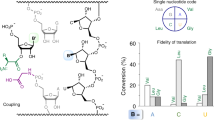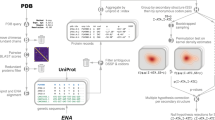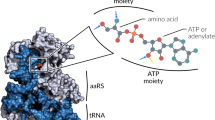Abstract
THREE general approaches can be used to determine the base sequence of natural messenger ribonucleic acids (mRNAs): (1) the molecular species in question can be purified and sequenced by chemical methods1; (2) purified aminoacyl-tRNAs (which are codon-specific) can be used to deliver labelled amino-acids to particular sites in a protein of known sequence2,3; and (3) the mRNA sequence can be inferred from the pattern of amino-acid substitutions in mutant proteins of known sequence4–6. It has been possible to determine indirectly the RNA sequence which codes for a carboxy-terminal segment of lysozyme4, but no intensive effort seems to have been made to apply the large amount of sequence data7 accumulated on homologous proteins to similar ends.
This is a preview of subscription content, access via your institution
Access options
Subscribe to this journal
Receive 51 print issues and online access
$199.00 per year
only $3.90 per issue
Buy this article
- Purchase on Springer Link
- Instant access to full article PDF
Prices may be subject to local taxes which are calculated during checkout
Similar content being viewed by others
References
De Wacter, R., and Fiers, W. W., Nature, 221, 233 (1969).
Gonano, F., Biochemistry, 6, 977 (1967).
Weisblum, B., Cherayil, J. D., Bock, E. M., and Soll, D. J., J. Mol. Biol., 28, 275 (1967).
Tsugita, A., Inouye, M., Imagawa, T., Nakaniski, T., Okada, Y., Emrich, J., and Streisinger, G., J. Mol. Biol., 41, 349 (1969).
Yanofsky, C., “Gene–Enzyme Relationships”, in The Bacteria (edit. by Gunsalus, I. C., and Stainer, R. Y.), 5, 373 (Academic Press, New York, 1964).
Sarabhai, A., Stretton, A. O. W., Brenner, S., and Bolle, A., Nature, 201, 13 (1964).
Dayhoff, M. O., and Eck, R. V., Atlas of Protein Sequence and Structure 1967–1968 (Silver Springs, Md., National Biomedical Research Foundation, 1968).
Caskey, C. T., Beaudet, A., and Nirenberg, M., J. Mol. Biol., 37, 99 (1968).
Lehmann, H., and Carrell, R. W., Brit. Med. Bull., 25, 14 (1969).
Crick, F. H. C., J. Mol. Biol., 19, 548 (1966).
Subak-Sharpe, H., Shepherd, W. M., and Hay, J., Cold Spring Harbor Symp. Quant. Biol., 31, 583 (1966).
Anderson, W. F., Biochem. Biophys. Res. Commun., 36, 456 (1969).
Clark, B. F. C., and Marcker, K. A., J. Mol. Biol., 17, 394 (1966).
Galper, J. B., and Darnell, J. E., Biochem. Biophys. Res. Commun., 34, 205 (1969).
Author information
Authors and Affiliations
Rights and permissions
About this article
Cite this article
LANKS, K. Biological Sciences: Derivation of Partial Sequence of Human β Chain Messenger RNA from Mutation Data. Nature 225, 1244–1245 (1970). https://doi.org/10.1038/2251244a0
Received:
Revised:
Issue Date:
DOI: https://doi.org/10.1038/2251244a0
This article is cited by
-
Assignment of Codons to Arginine Residues in Vertebrate Proteins
Nature New Biology (1973)
Comments
By submitting a comment you agree to abide by our Terms and Community Guidelines. If you find something abusive or that does not comply with our terms or guidelines please flag it as inappropriate.



